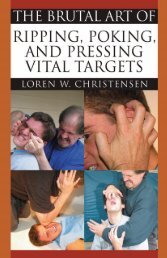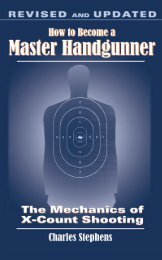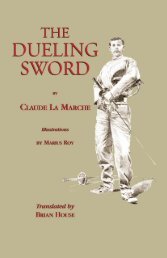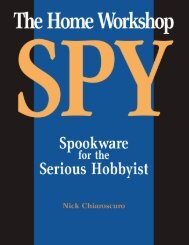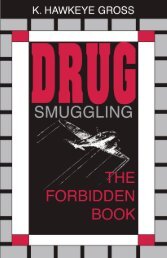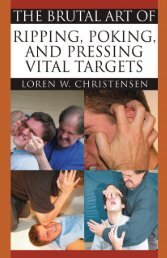Ragnar's Action Encyclopedia of Practical ... - Paladin Press
Ragnar's Action Encyclopedia of Practical ... - Paladin Press
Ragnar's Action Encyclopedia of Practical ... - Paladin Press
You also want an ePaper? Increase the reach of your titles
YUMPU automatically turns print PDFs into web optimized ePapers that Google loves.
IMPROVISED FIREARMS<br />
marginally better and penetration surprisingly good,<br />
provided you can make do with this sometimes<br />
cumbersome length.<br />
An extremely practical firearm can be made<br />
using 3/8-inch Schedule 40 pipe, firing .44 Mag and<br />
.44 Special, .45 auto rim, .45 Colt, and .410 shotgun<br />
ammo. Again, these are not common military<br />
cartridges, but the fact that it is both a hard ball and<br />
shot shell-type weapon recommends it. As with the<br />
.38 family <strong>of</strong> ammo, these are relatively lowpressure<br />
rounds throwing a huge projectile<br />
eminently useful at short ranges.<br />
Among improvised firearms it generally<br />
would be useful to know how to make either a<br />
long-barrel or pistol-length 9mm. Because 9mms<br />
(except .380) are rimless rounds, an additional<br />
expedient must be deployed before they can be<br />
used in simple homebuilts. Otherwise, the rounds<br />
will fall into the barrel unless you are very careful<br />
about chamber reaming.<br />
Use common 3/8-inch snap rings—available<br />
from most automotive supply houses—to headspace<br />
the cartridge. Place the ring on the cartridge in the<br />
extractor groove. When replacing the cartridge,<br />
change snap rings as well.<br />
Use a length <strong>of</strong> 1/4-inch Schedule 40 pipe for a<br />
9mm barrel. Using a 13/32 bit, drill down into the<br />
pipe on the breech end 3/4 inch. Be extremely<br />
cautious that this chamber is centered on the bore<br />
and that it does not go too deep.<br />
The breechblock can be a threaded-pipe-type<br />
end cap or a coupling and plug drilled to accept a<br />
firing pin. Dies can be purchased to cut threads for<br />
these breechblocks, but generally you are better<br />
served by allowing a plumbing shop or machine<br />
shop to do the work. Cost is extremely minimal, and<br />
you do not create undue suspicions since most<br />
plumbing supply people assume that the pipe is <strong>of</strong><br />
little value unthreaded.<br />
Home builders either construct a hammer out <strong>of</strong><br />
heavy strapping or use an appropriate-size door bolt.<br />
Either way, novice builders are usually surprised to<br />
discover how many rubber bands or retention<br />
springs it takes to reliably detonate a round.<br />
Triggers can be longer, small-diameter bolts<br />
with serrations filed in them as a sear notch to hold<br />
the hammer, or the hammer can simply be held back<br />
with your thumb. Real working triggers are always<br />
tough for home builders, but people <strong>of</strong>ten seem to<br />
come up with some extremely simple, clever,<br />
workable patterns.<br />
People should not give up just because they live<br />
where restrictive laws have caused crime to become<br />
rampant. Under conditions <strong>of</strong> extreme duress,<br />
similar to those in New York City today, it may be<br />
possible to construct a workable homebuilt firearm<br />
with nothing but empty cartridge cases for ammo.<br />
Remember, it takes only one or two shots to come<br />
up with a real firearm. Expedient reloading<br />
proceeds as follows.<br />
Carefully punch the spent primer from the<br />
empty case. Using a stout pin, pick the little anvil<br />
out <strong>of</strong> the back <strong>of</strong> the primer. Pick out all the used<br />
priming mixture from the little stamped-steel cup.<br />
Using a small nail, pop the dent back out <strong>of</strong> the cup.<br />
Recharge the primer with a mixture <strong>of</strong> the type<br />
made for dynamite primers or use the tip (only) <strong>of</strong><br />
strike-anywhere matches. Using a sharp razor blade<br />
and a drop or two <strong>of</strong> distilled water on a glass sheet,<br />
sever the match tips, cut them into pieces, and make<br />
a paste. Before it dries, carefully place this paste<br />
back into the straightened primer cup.<br />
Rather than attempting to replace the primer<br />
anvil in the tiny primer, drop the anvil into the case<br />
primer pocket first before replacing the recharged<br />
primer. This works well but rusts barrels so quickly<br />
that most users claim a mouse piddled there.<br />
Generally, home builders seem to prefer to<br />
manufacture sugar chlorate powder rather than oldfashioned<br />
black powder as a propellant. Use equal<br />
volumes <strong>of</strong> potassium chlorate and regular<br />
granulated household sugar.<br />
Very gently, without adding any water, melt the<br />
sugar as though you were starting a batch <strong>of</strong> fudge.<br />
When the sugar is melted, remove it from the fire<br />
and continue to stir vigorously. When the sugar<br />
cools to 135 degrees (or the point at which you can<br />
comfortably place your fingers in the melted sugar),<br />
dump in an equal volume <strong>of</strong> potassium chlorate.<br />
Continue to stir vigorously till everything is<br />
thoroughly mixed. If the sugar was initially too cold<br />
during the melting process, it won’t accept all the<br />
potassium chlorate. If the sugar is too hot when it is<br />
being blended, a nice cheery fire will result. Either<br />
way, the situation is not what you want.<br />
Start with small batches till the process is more<br />
familiar. Sugar is easy to find and cheap, but<br />
spoiling one’s potassium chlorate can be a bit pricey.<br />
3





